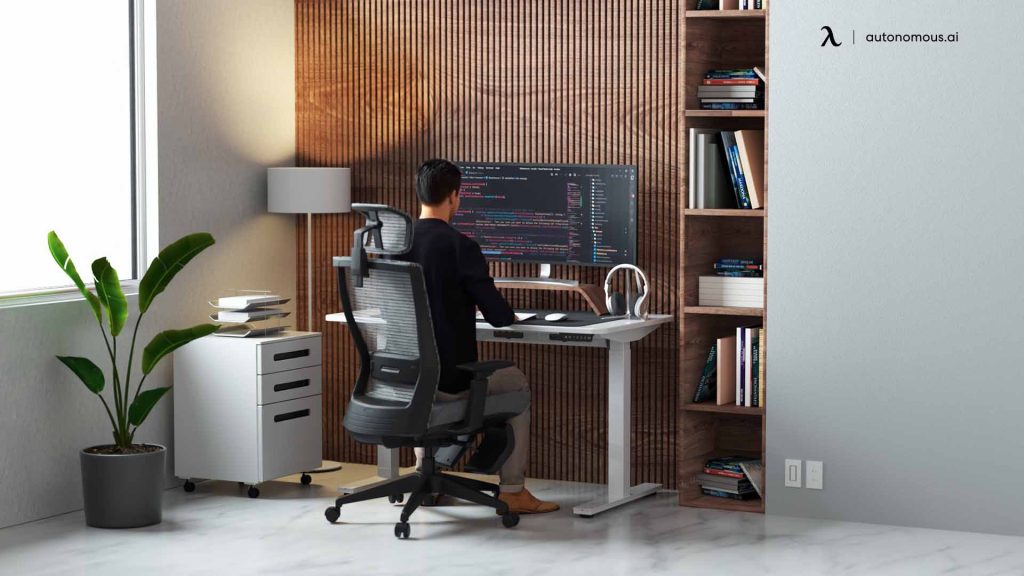In recent years, remote work has become a staple for many, with an increasing number of people spending their workdays from the comfort of their own homes. However, working from home comes with its own set of challenges—one of the most prominent being how to create an inspiring workspace that encourages productivity while also being comfortable and aesthetically pleasing.
Creating a workspace that is both functional and inspiring doesn’t require a huge budget or a complete home makeover. With some thoughtful planning and a few strategic choices, you can transform your home office into a space that fosters creativity, focus, and well-being. Here’s a guide to designing a home workspace that works for you, keeping both productivity and comfort in mind.

Why the Right Workspace Matters
A well-designed workspace does more than just look good. It has the power to enhance productivity, reduce stress, and improve overall well-being. A study conducted by the University of Exeter found that individuals working in well-designed environments reported better concentration and higher productivity levels. When you work in a space that is visually appealing, ergonomically supportive, and tailored to your needs, it can make all the difference in how you approach your tasks.
The key is to combine aesthetics with functionality. Whether you’re an entrepreneur, a remote worker, or simply someone who needs a quiet corner for focused work, the right space can boost your performance and mental clarity. Let’s explore the steps you can take to create a workspace that inspires you to do your best work.
Step 1: Prioritize Ergonomics for Comfort
Before diving into the visual elements of your workspace, it’s important to prioritize comfort. Hours of sitting at a desk can take a toll on your body, especially if your setup isn’t designed with ergonomics in mind. Ergonomic furniture is not just a luxury but a necessity to maintain posture and prevent strain.
- Ergonomic Chair: Choose a chair that supports your back, encourages good posture, and allows for adjustments to fit your body’s needs. A chair with adjustable armrests, lumbar support, and a comfortable seat cushion can make long workdays more bearable.
- Desk Height and Layout: Ensure your desk is at the right height so that your forearms are parallel to the ground when typing. If possible, invest in a sit-stand desk to alternate between sitting and standing throughout the day, which can reduce fatigue and improve circulation.
- Keyboard and Mouse: The keyboard and mouse should be positioned to keep your arms at a comfortable angle. Consider investing in an ergonomic keyboard or a mouse designed to reduce strain on your wrists.
A well-designed ergonomic setup will not only improve comfort but also reduce the likelihood of developing long-term issues like back pain or carpal tunnel syndrome.
Step 2: Create a Functional Layout
When arranging your workspace, it’s important to focus on how you’ll use the space. A cluttered, disorganized desk can lead to distractions and hinder your productivity. Take time to evaluate your workflow and design the layout based on your specific needs.
- Minimalist Approach: A minimalist layout is often the most effective. Keep only the essentials on your desk—your computer, a few writing tools, and anything else that directly contributes to your work. Avoid clutter, as it can create mental clutter as well.
- Storage Solutions: Invest in storage solutions that help you keep your workspace tidy. Use shelves, filing cabinets, and drawer organizers to keep paperwork and supplies out of sight. This ensures that your desk remains clean and free from distractions, promoting a more productive environment.
- Task Lighting: Good lighting is essential to reduce eye strain and create an inviting atmosphere. Ideally, position your desk near a window to take advantage of natural light. However, if that’s not possible, consider investing in a high-quality desk lamp with adjustable brightness to ensure you’re well-lit without being overwhelmed by harsh lighting.
A clean, organized, and well-lit space can help you feel more in control, focused, and ready to tackle your tasks.
Step 3: Incorporate Personal Touches for Inspiration
While functionality is essential, it’s also important to incorporate elements that inspire and motivate you. A workspace that reflects your personality and interests can help you feel more comfortable and invested in your work.
- Color Psychology: The colors you choose for your workspace can have a profound effect on your mood and productivity. For example, blue is known for promoting calm and focus, while yellow can stimulate creativity. Consider using accent colors that align with the feelings you want to evoke while working.
- Personal Artwork and Decor: Personalize your space with art, plants, or photographs that resonate with you. A piece of art that sparks creativity or a favorite quote that motivates you can help keep you focused and energized throughout the day. Indoor plants are particularly beneficial, as they improve air quality and have been shown to reduce stress levels.
- Vision Boards or Motivational Quotes: For an added boost, create a vision board or hang up motivational quotes in your workspace. These elements can serve as reminders of your goals and keep you inspired when you’re facing a challenging task.
Adding personal touches to your workspace can make it feel more like your own and less like just another place to work.
Step 4: Incorporate Technology to Enhance Workflow
In today’s digital age, integrating the right technology can vastly improve your efficiency and streamline your workflow.
- Multiple Monitors: If you find yourself juggling multiple tasks or documents, consider investing in a dual-monitor setup. Having two screens can help you multitask effectively and minimize the time spent switching between tabs.
- Task Management Tools: Use software like Trello, Asana, or Notion to stay organized and keep track of your to-do lists. These tools can help you break down tasks into manageable steps and track your progress throughout the day.
- Noise-Canceling Headphones: If you work in a noisy environment or simply prefer to block out distractions, noise-canceling headphones can help you stay focused and improve concentration.
By leveraging technology effectively, you can optimize your workspace and boost your productivity.
Step 5: Maintain a Healthy Work-Life Balance
Finally, remember that a workspace at home should support a healthy work-life balance. Working from home can blur the boundaries between personal and professional life, so it’s important to set clear boundaries and create a space that allows you to focus while also helping you unwind at the end of the day.
- Dedicated Work Zone: If possible, designate a specific area in your home as your work zone. This helps signal to your brain when it’s time to work and when it’s time to relax. Having a physical boundary between your work and personal space can help prevent burnout.
- Regular Breaks: Take frequent breaks throughout the day to stretch, walk around, or do something relaxing. Step away from your desk and allow your mind to recharge before returning to your tasks.
Ensuring that your workspace promotes balance is key to maintaining long-term productivity and mental well-being.
Conclusion
Creating an inspiring workspace at home is a thoughtful process that requires balancing functionality, comfort, and inspiration. By prioritizing ergonomics, organizing your workspace for efficiency, adding personal touches, integrating helpful technology, and fostering a healthy work-life balance, you can create a home office that not only enhances your productivity but also makes you feel motivated and comfortable.
Remember, the ideal workspace is one that makes you feel both focused and relaxed. With careful planning and a few design tweaks, you can create an environment that allows you to thrive in your remote work life.
References
- National Institute for Occupational Safety and Health (NIOSH). (2021). Preventing work-related musculoskeletal disorders: Ergonomics. Centers for Disease Control and Prevention. Available at: https://www.cdc.gov (Accessed: 19 August 2025).
- Psychology Today. (2020). How color affects your mood at work. Psychology Today. Available at: https://www.psychologytoday.com (Accessed: 19 August 2025).
- Journal of Environmental Psychology. (2019). The role of plants in workspace productivity. Journal of Environmental Psychology, Available at: https://www.sciencedirect.com (Accessed: 19 August 2025).









